Malaysia Flight – Search Director Disagrees That Pilot Ditched Plane , But Existing Technology Should Have Solved the Mystery Years Ago – Expert
WASHINGTON, D.C. (May 22, 2018): Peter Foley, the official who directed the hunt for the final seabed resting place of the missing Malaysia 370 flight, strongly disagrees with the conclusions of a so-called “expert panel” that the cause of “the greatest aviation mystery of all time” was the deliberate act of the pilot in depressurizing the plane and then ditching it in unexplored depths of the Indian Ocean.
This theory was laid out by Canadian air crash investigator Larry Vance in a new book entitled “MH370: Mystery Solved.” In it he argues that two wing flaps found on islands off Africa point to the pilot performing a controlled ditching outside the area scoured by sonar.
In contrast, the Australian Transport Safety Bureau [ATSB] still believes Flight 370 simply ran out of fuel and crashed after flying off course en route from Malaysia to Beijing in 2014.
Now, with the sharply differing conclusions of a so-called expert panel, and the official conclusion of the ATSB, we will probably never know for sure, despite 4 years of searching and over $160 million in costs, the true cause of the crash, and the same tragedy could easily happen again.
Tragically the flight’s remains, with invaluable information about what caused the mysterious crash, may never be recovered, although they should have been easy and inexpensive to find, says MIT-trained Professor John Banzhaf, who has two U.S. Patents and many technical papers to his credit.
A simple piece of existing technology – known as floatable EPIRBs – should have told us exactly where the plane came down within minutes after it occurred, and provided its black box data then.
Ships are required to have on board EPIRBs [Emergency Position Indicating Radio Beacons], a technology which has been in use for decades in marine environments. When activated, these devices send out an emergency distress signal to search-and-rescue satellites which indicates the identity of the caller.
If linked – as even small personal hand-held EPIRB devices now commonly are – to a GPS locator of the kind found in many cell phones, it would also provide their location with almost pinpoint accuracy, and also permit rescuers or others who subsequently arrive on the scene to hone in on its signal.
“If all of this can be packed into a small hand-held device weighing only ounces, which can transmit your identity and location anywhere in the world for at least 24 hours, and is even waterproof and designed to float to the surface, there is no reason why EPIRBs on planes and ejected upon a crash should not be able to do the same with a much more powerful signal, and able to last for weeks if not for months.”
“This is much better than black boxes sending out pings from vast depths which can be detected only by craft closer than a few miles away searching a wide swath of ocean,” adds Banzhaf.
In addition, since all of the vital information contained in black boxes can now be stored in tiny thumb-sized computer storage devices, which have no moving parts and are therefore largely invulnerable even to forces generated in plane crashes, there is no reason why the EPIRB device could not also store duplicates of the same data which is now stored only in the plane’s black boxes.
It’s a lot easier to recover this invaluable data from floating EPIRB devices sending out homing signals than to try to retrieve the actual block boxes which are almost certainly deep under water, and which may be so damaged by the time they are recovered that the information is lost, says Banzhaf.
These devices would store – and provide to authorities – detailed information about virtually everything that happened to the plane, including the last several hours of what was said in the cockpit.
Many EPIRBs intended for ocean use are designed to be “floatable,” so that they are automatically released if the water pressure on them exceeds that found at a specified depth.
Making it possible for rescuers to locate exactly where the plane hit the water, and to find almost immediately – floating on the surface – detailed information about what happened, would be far preferable to having authorities try to search thousands of square miles of ocean bottom listening for a faint ping, and then trying to recover this invaluable information from the ocean bottom, says Banzhaf.
It’s obviously too late to rely upon such devices to solve the 370 mystery and save millions in search expenses, says Banzhaf, but it’s not too late to begin requiring such devices on many larger aircraft.
JOHN F. BANZHAF III, B.S.E.E., J.D., Sc.D.
Professor of Public Interest Law
George Washington University Law School




